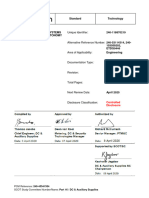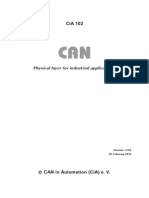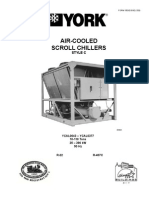90 9
90 9
Uploaded by
Armin Fernández GerardoCopyright:
Available Formats
90 9
90 9
Uploaded by
Armin Fernández GerardoOriginal Title
Copyright
Available Formats
Share this document
Did you find this document useful?
Is this content inappropriate?
Copyright:
Available Formats
90 9
90 9
Uploaded by
Armin Fernández GerardoCopyright:
Available Formats
90.
8 Article 90
Introduction
8 2011 National Electrical Code Handbook
mercial and industrial facilities, it is common to purchase
switchboards with additional capacity to accommodate fu-
ture expansion. See Exhibit 90.3.
(B) Number of Circuits in Enclosures. It is elsewhere
provided in this Code that the number of wires and circuits
confined in a single enclosure be varyingly restricted. Limit-
ing the number of circuits in a single enclosure minimizes
the effects from a short circuit or ground fault in one circuit.
These limitations minimize the heating effects inherently
present wherever current-carrying conductors are grouped
together. See 408.36, Exception No. 2 for restrictions on the
number of overcurrent devices on one panelboard.
90.9 Units of Measurement
(A) Measurement System of Preference. For the purpose
of this Code, metric units of measurement are in accordance
with the modernized metric system known as the Interna-
tional System of Units (SI).
According to a recent report titled A Metric for Success by
the National Institute of Standards and Technology (NIST),
most U.S. industries that do business abroad are predomi-
nantly metric already because of global sourcing of parts,
service, components, and production. However, quite a few
domestic industries still use U.S. customary units. The NIST
report warns that domestic industries that ignore global reali-
ties and continue to design and manufacture with nonmetric
measures will find that they risk increasing their costs. Non-
metric modular products (the building construction industry
uses great quantities of modular parts) and those that inter-
face with outside industry products are especially vulnerable
to the added costs of adapting to a metric environment.
Metric standards are beginning to appear in the domes-
tic building construction industry because our national stan-
dards are being harmonized with international standards.
(B) Dual System of Units. SI units shall appear first, and
inch-pound units shall immediately follow in parentheses.
Conversion from inch-pound units to SI units shall be based
on hard conversion except as provided in 90.9(C).
(C) Permitted Uses of Soft Conversion. The cases given in
90.9(C)(1) through (C)(4) shall not be required to use hard
conversion and shall be permitted to use soft conversion.
(1) Trade Sizes. Where the actual measured size of a prod-
uct is not the same as the nominal size, trade size designa-
tors shall be used rather than dimensions. Trade practices
shall be followed in all cases.
equipment and materials that have been tested and meet na-
tionally recognized standards or that have been found suit-
able for use in a specified manner. The Code does not contain
detailed information on equipment or materials but refers to
products as listed, labeled, or identified. See Article 100 for
definitions of these terms. Many certification agencies also
perform field evaluations of specific installations in order to
render an opinion on compliance with the requirements of
the Code, along with any applicable product standards.
NFPA does not approve, inspect, or certify any installa-
tions, procedures, equipment, or materials, nor does it ap-
prove or evaluate testing laboratories. In determining the
acceptability of installations or procedures, equipment, or
materials, the authority having jurisdiction may base accep-
tance on compliance with NFPA or other appropriate stan-
dards. In the absence of such standards, the authority may
require evidence of proper installation, procedures, or use.
The authority having jurisdiction may also refer to the listing
or labeling practices of an organization concerned with prod-
uct evaluations in order to determine compliance with appro-
priate standards for the current production of listed items.
Informative Annex A contains a list of product safety
standards used for product listing. The list includes only
product safety standards for which a listing is required by
the Code. For example, 344.6 requires that rigid metal con-
duit, Type RMC, be listed. By using Informative Annex A,
the user finds that the listing standard for rigid metal conduit
is UL 6, Rigid Metal Conduit. Because associated conduit
fittings are required to be listed, UL 514B, Fittings for Cable
and Conduit, is found in Informative Annex A also.
90.8 Wiring Planning
(A) Future Expansion and Convenience. Plans and spec-
ifications that provide ample space in raceways, spare race-
ways, and additional spaces allow for future increases in
electric power and communications circuits. Distribution
centers located in readily accessible locations provide con-
venience and safety of operation.
The requirement for providing the exclusively dedicated
equipment space mandated by 110.26(E) supports the intent
of 90.8(A) regarding future increases in the use of electric-
ity. It is important to consider communications circuits when
planning future needs. Electrical and communications distri-
bution centers should contain additional space and capacity
for future additions and should be conveniently located for
easy accessibility.
Where electrical and communications distribution
equipment is installed so that easy access cannot be
achieved, a spare raceway(s) or pull line(s) should be run at
the initial installation, as illustrated in Exhibit 90.2. In com-
Article 90
Introduction 90.9
National Electrical Code Handbook 2011 9
Metric trade sizes (metric designators) of conduits appear in
the Code text, preceding the trade size equivalents, in the
raceway articles.
For example, in 350.20(A) of this Code, the size re-
quirement is stated as follows: LFMC smaller than metric
designator 16 (trade size
1
2) shall not be used.
This convention provides acceptable language to both
domestic and international users of the NEC. For ease of
use, in Table 4 of Chapter 9, metric designators and trade
sizes are in separate columns.
(2) Extracted Material. Where material is extracted from
another standard, the context of the original material shall
not be compromised or violated. Any editing of the extracted
text shall be confined to making the style consistent with
that of the NEC.
(3) Industry Practice. Where industry practice is to ex-
press units in inch-pound units, the inclusion of SI units
shall not be required.
The following calculation examples illustrate conversions
from U.S. customary units (sometimes referred to as inch-
pound units) to SI units. Example 1 shows the process of
converting a dimension from feet to meters, where safety is
a concern. Table 110.31 contains minimum permitted dis-
tances from a fence to a live part for voltages 601 and
greater.
Calculation Example 1
Determine the equivalent metric conversion for 10 ft where
the calculation could have a negative impact on safety, such
as the minimum distance of 10 ft given in Table 110.31, and
where the measurement is from a fence to a live part from
601 volts to 13,799 volts.
Solution
STEP 1. Use the following equation to determine the equiv-
alent metric conversion for 10 ft:
10 ft
0.3048 m
1 ft
= 3.048 m
STEP 2. Round up the calculation to 3.05 m because a dis-
tance less than 3.048 could have a negative impact on safety.
The answer, 3.05 m, matches the minimum distance in Table
110.31 from a fence to a live part from 601 volts to 13,799
volts.
Because safety is a concern for this conversion calcula-
tion, the original Code distance (the U.S. customary units
for this example) remains the shortest permitted distance.
EXHIBIT 90.2 A residential dis-
tribution system showing spare
raceways or pull lines that allow
for future circuits and loads for
both electrical and communica-
tions systems.
Spare raceways or pull lines
from electrical service panel
and communications center
to accessible attic space
Junction
boxes
Unfinished
utility area
Finished
basement area
Raceway
or pull
lines
Service
panel
Communications
equipment
90.9 Article 90
Introduction
10 2011 National Electrical Code Handbook
The final metric equivalent ends up slightly larger. The exact
difference is of no practical concern, however, because 0.2
mm is less than
1
32 in. From a practical point of view, a vari-
ance of
1
32 in. in a length of 10 ft is insignificant.
Calculation Example 2
Using the soft-conversion method, determine the equivalent
metric conversion for 30 in. where the calculation could
have a negative impact on safety, such as a 30-in. minimum
horizontal working space requirement in the rear of equip-
ment that requires access to nonelectrical parts according to
110.26(A)(1)(a).
Solution
STEP 1. Use the following equation to determine the equiv-
alent metric conversion for 30 in.:
30 in.
25.4 mm
1 in.
= 762 mm
STEP 2. Do not round off the calculation, because even a
slight reduction in the original distance could have a nega-
tive impact on safety. The answer is 762 mm, which matches
the minimum distance of 110.26(A)(1)(a) for a minimum
horizontal working space.
(4) Safety. Where a negative impact on safety would result,
soft conversion shall be used.
Hard conversion is explained in the informational note No. 1
following 90.9(D). Calculations to convert measurements
from inch-pound units to metric units must be made using
hard conversion. The hard-conversion method is mandatory
except for trade sizes [e.g., raceway sizes in Table 300.1(C)],
extracted material (e.g., class and zone measurements from
other NFPA documents), and safety calculations (e.g., mini-
mum distances taken from Table 110.31).
Calculation Example
Using the hard-conversion method, determine the equivalent
metric conversion for 24 in., generally the minimum cover
requirements for direct burial cables and conductors in non-
specific locations taken from row 1 of Table 300.5.
Solution
STEP 1. Use the following equation to determine the equiv-
alent metric conversion for 24 in.:
24 in.
25.4 mm
1 in.
= 609.6 mm
STEP 2. Because the calculation is being performed as a hard
conversion, the 609.6 mm dimension may be changed, and
the selected equivalent cover requirement is 600 mm.
The measurements of 600 mm and 24 in. appear in
Table 300.5 for the minimum cover requirements for direct
burial cables and conductors in nonspecific locations. For
the 1999 NEC, the selected SI unit of measure was required
to be 609.6 mm. The 2005 Code (as well as the 2002 Code)
permitted much more latitude for the final selected dimen-
sion, and so the equivalent minimum cover requirement of
600 mm is a more practical solution. Basically, a hard con-
version permits a change in a dimension or allows rounding
up or down to better fit the physical constraints of the instal-
lation.
(D) Compliance. Conversion from inch-pound units to SI
units shall be permitted to be an approximate conversion.
Compliance with the numbers shown in either the SI system
EXHIBIT 90.3 A switchboard with spare circuit breakers in-
stalled to facilitate future growth. (Courtesy of the International
Association of Electrical Inspectors)
Article 90
Introduction 90.9
National Electrical Code Handbook 2011 11
COMMENTARY TABLE 90.1 Conversions Using the Hard-
Conversion Method
U.S.
Customary
Units
Soft
Conversions,
SI Units
Hard
Conversions,
SI Units
Equivalent U.S.
Customary Units
1
2 in.
3
4 in.
1 in.
4 in.
12 in.
2 ft
3 ft
6 ft
15 ft
12.7 mm
19 mm
25.4 mm
102 mm
305 mm
610 mm
914 mm
1.83 m
4.57 m
13 mm
19 mm
25 mm
100 mm
300 mm
600 mm
900 mm
1.8 m
4.5 m
0.51 in.
0.75 in.
0.98 in.
3.94 in.
11.81 in.
1.97 ft
2.95 ft
5.91 ft
14.76 ft
or the inch-pound system shall constitute compliance with
this Code.
Informational Note No. 1: Hard conversion is considered a
change in dimensions or properties of an item into new sizes
that might or might not be interchangeable with the sizes
used in the original measurement. Soft conversion is consid-
ered a direct mathematical conversion and involves a change
in the description of an existing measurement but not in the
actual dimension.
Informational Note No. 2: SI conversions are based on
IEEE/ASTM SI 10-1997, Standard for the Use of the Inter-
national System of Units (SI): The Modern Metric System.
Commentary Table 90.1 offers some examples of the hard-
conversion process. The equivalent U.S. units are given only
to show the small variance between customary units and the
hard-conversion units.
Warning signs that state specific clearances, such as re-
quired in 513.10(B), permit distance measurements in either
inch-pound units or metric units.
You might also like
- Telecommunications Distribution Methods Manual (TDMM), 13th EditionDocument88 pagesTelecommunications Distribution Methods Manual (TDMM), 13th EditionLeslie Hicks100% (2)
- 240-118870219 Standby Power Systems Topology and Autonomy For Eskom SitesDocument31 pages240-118870219 Standby Power Systems Topology and Autonomy For Eskom SitesiabhuaNo ratings yet
- Substation Automation Systems: Design and ImplementationFrom EverandSubstation Automation Systems: Design and ImplementationRating: 4.5 out of 5 stars4.5/5 (3)
- JKR GuidelinesDocument22 pagesJKR Guidelinessulphurdioxide100% (2)
- Tangedco-Abt Meter Final Spec. (Both Bulk & WFHT SC)Document34 pagesTangedco-Abt Meter Final Spec. (Both Bulk & WFHT SC)Arun MuruganNo ratings yet
- 102 v03000003 Physical LayerDocument7 pages102 v03000003 Physical LayerhcoolmanNo ratings yet
- 2011 NEC Code 310.15B3cDocument7 pages2011 NEC Code 310.15B3cKhaldoon AlnashiNo ratings yet
- UL Listed 100%-Rated Molded Case Circuit Breakers: Application Paper AP01200008EDocument4 pagesUL Listed 100%-Rated Molded Case Circuit Breakers: Application Paper AP01200008EGlenn Adalia BonitaNo ratings yet
- DLMS Spec For Bulk MetersDocument36 pagesDLMS Spec For Bulk MetersSuresh UmadiNo ratings yet
- Tsewg Tp-11 Ufc 3-500-10n Best PracticesDocument7 pagesTsewg Tp-11 Ufc 3-500-10n Best PracticeshopkitNo ratings yet
- Sample Busduct SpecsDocument15 pagesSample Busduct SpecsONILEDA1970No ratings yet
- National Grid Design Handbook dh01Document26 pagesNational Grid Design Handbook dh01akmezim100% (2)
- Substationsfinal2013 PDFDocument137 pagesSubstationsfinal2013 PDFManoj RanaNo ratings yet
- Guidelines For Grounding and Bonding Telecom SystemsDocument5 pagesGuidelines For Grounding and Bonding Telecom SystemsSDE BSS KollamNo ratings yet
- Coordination of Relays, Reclosers, and Sectionalizing Fuses For Overhead Lines in The Oil PatchDocument8 pagesCoordination of Relays, Reclosers, and Sectionalizing Fuses For Overhead Lines in The Oil PatchluhusapaNo ratings yet
- Guidelines For Grounding and Bonding Telecom Systems-EC&MDocument5 pagesGuidelines For Grounding and Bonding Telecom Systems-EC&MJOSE LUIS FALCON CHAVEZNo ratings yet
- Basics - of - Grounding and BondingDocument8 pagesBasics - of - Grounding and BondingSegun KehindeNo ratings yet
- 2014 - Feb - TP CSI Estimating SampleDocument15 pages2014 - Feb - TP CSI Estimating SampleLv WanyNo ratings yet
- Design Criteria Electrical 20110928Document20 pagesDesign Criteria Electrical 20110928Nghia Huynh NgocNo ratings yet
- Article 90. Introduction: 90.1. Purpose (A) - Practical SafeguardingDocument14 pagesArticle 90. Introduction: 90.1. Purpose (A) - Practical SafeguardingLaurence MalanumNo ratings yet
- E GC8181 GDocument16 pagesE GC8181 GDeepa DevarajNo ratings yet
- HB 103-1997 (CJC 7) Coordination of Power and Telecommunications - Crossings Code - The Arrangement of OverheaDocument8 pagesHB 103-1997 (CJC 7) Coordination of Power and Telecommunications - Crossings Code - The Arrangement of OverheaSAI Global - APACNo ratings yet
- Nec 2017Document48 pagesNec 2017Victor RestrepoNo ratings yet
- Cable and Conduit Size Design GuideDocument9 pagesCable and Conduit Size Design GuideKannuru Tarakeswara RaoNo ratings yet
- Cat 6 Shielded Patch Cords: Product SpecificationDocument5 pagesCat 6 Shielded Patch Cords: Product SpecificationAngelica Baena CuestaNo ratings yet
- Field Testing of Overcurrent Trip Units For Low Voltage Circuit Breakers Used in DC ApplicationsDocument36 pagesField Testing of Overcurrent Trip Units For Low Voltage Circuit Breakers Used in DC Applicationsarshu1463No ratings yet
- Tia Eia 613Document19 pagesTia Eia 613NeatMarineNo ratings yet
- Ahu 21Document68 pagesAhu 21pursuitofhappynessinNo ratings yet
- 2423 SpecDocument50 pages2423 SpecAssistant EngineerNo ratings yet
- VicRoads Bridge Design Technical NotesDocument111 pagesVicRoads Bridge Design Technical NotesJunnoKaiserNo ratings yet
- Cable Tray InstallationDocument10 pagesCable Tray Installationalrwin_b2yNo ratings yet
- BT Sin 349Document11 pagesBT Sin 349Ary SudarmantoNo ratings yet
- GuideToSupplyMetering 270810 FinalDocument21 pagesGuideToSupplyMetering 270810 FinalZafira FirzanahNo ratings yet
- Project Specification: Motor-Control Centers For HvacDocument15 pagesProject Specification: Motor-Control Centers For HvacSoumojit SamantaNo ratings yet
- ANSI - SCTE - 48!3!2011 Test Procedure For Measuring Shielding Effectiveness of Braided Coaxial Drop Cable Using The GTEM CellDocument17 pagesANSI - SCTE - 48!3!2011 Test Procedure For Measuring Shielding Effectiveness of Braided Coaxial Drop Cable Using The GTEM CellYung SangNo ratings yet
- RMS Pre-Bid PresentationDocument64 pagesRMS Pre-Bid PresentationShahid MahmoodNo ratings yet
- Httpswww.centerpointenergy.comen UsDocumentsService Standards.pdfDocument108 pagesHttpswww.centerpointenergy.comen UsDocumentsService Standards.pdfcjflores0704No ratings yet
- DesignOptimization Al X CuDocument17 pagesDesignOptimization Al X CuFaycel MekadminiNo ratings yet
- 2 Cable Trunking and DuctsDocument8 pages2 Cable Trunking and Ductsaanouar77No ratings yet
- CIGRE-118 Practical Experience With IEEE 1588 High Precision Time Synchronization in Electrical Substation Based On IEC 61850 Process BusDocument10 pagesCIGRE-118 Practical Experience With IEEE 1588 High Precision Time Synchronization in Electrical Substation Based On IEC 61850 Process BusEleazar Sierra EspinozaNo ratings yet
- Reference Architecture Design Guide Part 3,0Document100 pagesReference Architecture Design Guide Part 3,0gurkan arif yalcinkayaNo ratings yet
- Tse 00 3 PS 0800 Fkec D El Rep 00008Document12 pagesTse 00 3 PS 0800 Fkec D El Rep 00008Khaled Abdel-GalilNo ratings yet
- Transmission Line ManualDocument20 pagesTransmission Line ManualSrinath Rao Bompalli50% (2)
- 27 - 512 MHZ AntennasDocument192 pages27 - 512 MHZ AntennasGiorgi PapavaNo ratings yet
- Alcan Cable: A Growing TrendDocument3 pagesAlcan Cable: A Growing TrendCarlos Lino Rojas AgüeroNo ratings yet
- 1996oct DecDocument6 pages1996oct DecGunadevan ChandrasekaranNo ratings yet
- 2017 Code Changes SummaryDocument17 pages2017 Code Changes SummaryKim LucenaNo ratings yet
- Planning of Electric Power Distribution Technical PrinciplesDocument6 pagesPlanning of Electric Power Distribution Technical Principlesgl1188No ratings yet
- Nec Branch Circuit CalculationsDocument9 pagesNec Branch Circuit CalculationsAMIR ANWARNo ratings yet
- 3 LT CT Operated Meter With Net Metering Arrangement 22.01.2016Document48 pages3 LT CT Operated Meter With Net Metering Arrangement 22.01.2016kunalr.dhakateNo ratings yet
- Estimator's Piping Man-hours Tool: Estimating Man-hours for Carbon Steel Process Piping Projects. Manual of Man-hours, ExamplesFrom EverandEstimator's Piping Man-hours Tool: Estimating Man-hours for Carbon Steel Process Piping Projects. Manual of Man-hours, ExamplesNo ratings yet
- How to prepare Welding Procedures for Oil & Gas PipelinesFrom EverandHow to prepare Welding Procedures for Oil & Gas PipelinesRating: 5 out of 5 stars5/5 (1)
- High-Performance D/A-Converters: Application to Digital TransceiversFrom EverandHigh-Performance D/A-Converters: Application to Digital TransceiversNo ratings yet
- BICSI RCDD Registered Communications Distribution Designer Exam Prep And Dumps RCDD-001 Exam Guidebook Updated QuestionsFrom EverandBICSI RCDD Registered Communications Distribution Designer Exam Prep And Dumps RCDD-001 Exam Guidebook Updated QuestionsNo ratings yet
- Arduino Measurements in Science: Advanced Techniques and Data ProjectsFrom EverandArduino Measurements in Science: Advanced Techniques and Data ProjectsNo ratings yet
- Design and Test Strategies for 2D/3D Integration for NoC-based Multicore ArchitecturesFrom EverandDesign and Test Strategies for 2D/3D Integration for NoC-based Multicore ArchitecturesNo ratings yet
- The Internet of Things: Key Applications and ProtocolsFrom EverandThe Internet of Things: Key Applications and ProtocolsRating: 5 out of 5 stars5/5 (1)
- Elastimold Connectors Loadbreak and Deadbreak Elbow and Bolted Tee Connectors HV MV 600 SeriesDocument8 pagesElastimold Connectors Loadbreak and Deadbreak Elbow and Bolted Tee Connectors HV MV 600 SeriesArmin Fernández GerardoNo ratings yet
- Tabla C1Document59 pagesTabla C1Armin Fernández GerardoNo ratings yet
- Gas Station WiringDocument2 pagesGas Station WiringArmin Fernández Gerardo33% (3)
- 110 26Document9 pages110 26Armin Fernández GerardoNo ratings yet
- Elastimold CableDocument40 pagesElastimold CableArmin Fernández GerardoNo ratings yet
- Grounding and Bonding Methods For Outbuildings - International Association of ElDocument6 pagesGrounding and Bonding Methods For Outbuildings - International Association of ElArmin Fernández GerardoNo ratings yet
- Art 230 ServicesDocument14 pagesArt 230 ServicesArmin Fernández GerardoNo ratings yet
- Nema SG 10-2019 Watermark - 2024-11-18Document19 pagesNema SG 10-2019 Watermark - 2024-11-18KurtNo ratings yet
- Prosonic S FMU90 HartDocument160 pagesProsonic S FMU90 HartGiorgio KappasNo ratings yet
- MC InstallGuide PDFDocument56 pagesMC InstallGuide PDFrqodriNo ratings yet
- Cummins Hylyzer 250 SpecsheetDocument2 pagesCummins Hylyzer 250 SpecsheetamsukdNo ratings yet
- Cable Tray CatalogueDocument57 pagesCable Tray CatalogueEmad ArafaNo ratings yet
- LPT0002 002aDocument48 pagesLPT0002 002aJorge Frent De Buey PejugageNo ratings yet
- Ultramount Weigh Modules: Service ManualDocument48 pagesUltramount Weigh Modules: Service ManualRicardo Vazquez SalinasNo ratings yet
- Maintenance of Electrical Switch GearDocument190 pagesMaintenance of Electrical Switch Gearmustaqu100% (3)
- Wiha Insulated CatalogDocument32 pagesWiha Insulated CatalogCarbide Processors IncNo ratings yet
- Overcurrent ProtectionDocument23 pagesOvercurrent ProtectiondaodoquangNo ratings yet
- ELT-01-EE-TS-0012 - Specification For Earthing and Lightning Protection System - R0Document15 pagesELT-01-EE-TS-0012 - Specification For Earthing and Lightning Protection System - R0jorgekarlosprNo ratings yet
- ElectriCalc Pro ManualDocument71 pagesElectriCalc Pro ManualJuanDavinci100% (1)
- 06-237463-001 - Aegis 2.0 Manual - AADocument102 pages06-237463-001 - Aegis 2.0 Manual - AALUIS FELIPE LIZCANO MARIN50% (2)
- Basic Electrical Requirment KSADocument10 pagesBasic Electrical Requirment KSAfarooq929No ratings yet
- General Dwelling Calculation Method of Load (NEC 2002)Document3 pagesGeneral Dwelling Calculation Method of Load (NEC 2002)RudanekNo ratings yet
- Gamewell E3 ManualDocument102 pagesGamewell E3 ManualJhonny López Alcalá0% (1)
- Installation Guide Goodman ARUF CPDocument13 pagesInstallation Guide Goodman ARUF CPSaúl OrtizNo ratings yet
- YCAL0317CDocument114 pagesYCAL0317CDaniel Pinto GodoyNo ratings yet
- The Basics of Large Dry-Type Transformers - Content Content From Electrical Construction & Maintenance (EC&M) MagazineDocument5 pagesThe Basics of Large Dry-Type Transformers - Content Content From Electrical Construction & Maintenance (EC&M) MagazineRAPRATSINNo ratings yet
- Module 1 of EIM NC II UNIT 1Document31 pagesModule 1 of EIM NC II UNIT 1John Roy GarzonNo ratings yet
- LPR1710 6Document54 pagesLPR1710 6Ruben GutierrezNo ratings yet
- Seguridad ElectricaDocument18 pagesSeguridad Electricajorge rodriguezNo ratings yet
- KV-5500/5000/3000/ 1000/700 Series: Programmable ControllerDocument8 pagesKV-5500/5000/3000/ 1000/700 Series: Programmable ControllerĐinh Tiến NamNo ratings yet
- Draft Zoning Ordinance (2012-2021) 2Document66 pagesDraft Zoning Ordinance (2012-2021) 2Kaitey Ü Chums100% (1)
- Wheelock-Mt12-24 Horn-InstallDocument3 pagesWheelock-Mt12-24 Horn-InstallSergio Dal DossoNo ratings yet
- S9 Safety Labeling For Electrical Equipment and Facilities ManagementDocument74 pagesS9 Safety Labeling For Electrical Equipment and Facilities Managementalfonzo.keilerNo ratings yet
- Practical Guidelines For Electrical Area Classification inDocument11 pagesPractical Guidelines For Electrical Area Classification inaliris322No ratings yet
- LV Cable InstallationDocument20 pagesLV Cable Installationkailasamvv100% (1)
- Amazon Basics UPS User ManualDocument17 pagesAmazon Basics UPS User Manualpepperfamily7No ratings yet
































































































